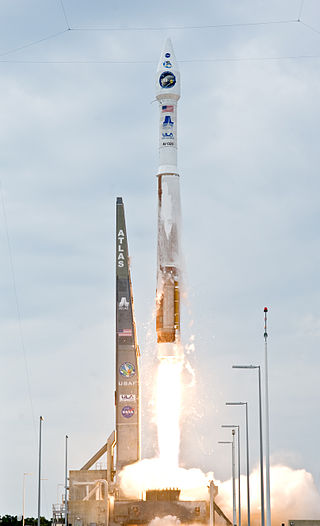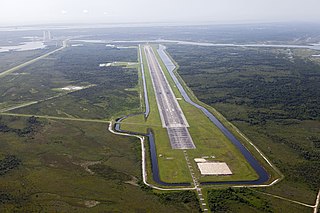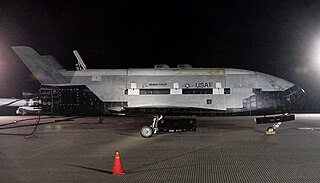
Cape Canaveral Space Force Station (CCSFS) is an installation of the United States Space Force's Space Launch Delta 45, located on Cape Canaveral in Brevard County, Florida.

A spaceplane is a vehicle that can fly and glide like an aircraft in Earth's atmosphere and maneuver like a spacecraft in outer space. To do so, spaceplanes must incorporate features of both aircraft and spacecraft. Orbital spaceplanes tend to be more similar to conventional spacecraft, while sub-orbital spaceplanes tend to be more similar to fixed-wing aircraft. All spaceplanes to date have been rocket-powered for takeoff and climb, but have then landed as unpowered gliders.

Orbiter Processing Facility (OPF) is a class of hangars where U.S. Space Shuttle orbiters underwent maintenance between flights. They are located west of the Vehicle Assembly Building, where the orbiter was mated with its External Tank and Solid Rocket Boosters before transport to the launch pad. OPF-1 and OPF-2 are connected with a low bay between them, while OPF-3 is across the street.

The Boeing X-37, also known as the Orbital Test Vehicle (OTV), is a reusable robotic spacecraft. It is boosted into space by a launch vehicle, then re-enters Earth's atmosphere and lands as a spaceplane. The X-37 is operated by the Department of the Air Force Rapid Capabilities Office, in collaboration with United States Space Force, for orbital spaceflight missions intended to demonstrate reusable space technologies. It is a 120-percent-scaled derivative of the earlier Boeing X-40. The X-37 began as a NASA project in 1999, before being transferred to the United States Department of Defense in 2004. Until 2019, the program was managed by Air Force Space Command.

Atlas V is an expendable launch system and the fifth major version in the Atlas launch vehicle family. It was originally designed by Lockheed Martin, now being operated by United Launch Alliance (ULA), a joint venture between Lockheed Martin and Boeing. It is used for DoD, NASA, and Commercial payloads. It is America's longest-serving active rocket. After 87 launches, in August 2021 ULA announced that Atlas V would be retired, and all 29 remaining launches had been sold. As of 6 October 2023, 17 launches remain.

FalconSAT is the United States Air Force Academy's (USAFA) small satellite engineering program. Satellites are designed, built, tested, and operated by Academy cadets. The project is administered by the USAFA Space Systems Research Center under the direction of the Department of Astronautics. Most of the cadets who work on the project are pursuing a bachelor of science degree in astronautical engineering, although students from other disciplines join the project.

The Shuttle Landing Facility (SLF), also known as Launch and Landing Facility (LLF), is an airport located on Merritt Island in Brevard County, Florida, United States. It is a part of the Kennedy Space Center and was used by Space Shuttle for landing until July 2011. It was also used for takeoffs and landings for NASA training jets such as the Shuttle Carrier Aircraft and for civilian aircraft.

United Launch Alliance, LLC, commonly referred to as ULA, is an American aerospace manufacturer, defense contractor and launch service provider that manufactures and operates a number of rocket vehicles that launch spacecraft into orbits around Earth and other bodies in the Solar System.

The Wideband Global SATCOM system (WGS) is a high capacity United States Space Force satellite communications system planned for use in partnership by the United States Department of Defense (DoD), Canadian Department of National Defence (DND) and the Australian Department of Defence. The system is composed of the Space Segment satellites, the Terminal Segment users and the Control Segment operators.

USA-212 was the first flight of the Boeing X-37B Orbital Test Vehicle 1, an American robotic vertical-takeoff, horizontal-landing (VTHL) spaceplane. It was launched aboard an Atlas V rocket from Cape Canaveral on 22 April 2010, and operated in low Earth orbit. Its designation is part of the USA series.

USA-226 was the first flight of the second Boeing X-37B, the Orbital Test Vehicle 2, an American unmanned robotic vertical-takeoff, horizontal-landing spaceplane. It was launched aboard an Atlas V rocket from Cape Canaveral on 5 March 2011, and landed at Vandenberg Air Force Base on 16 June 2012. It operated in low Earth orbit. Its mission designation is part of the USA series.

USA-233, or Wideband Global SATCOM 4 (WGS-4) is a United States military communications satellite operated by the United States Air Force as part of the Wideband Global SATCOM program, launched in 2012. The fourth Wideband Global SATCOM satellite, it is the first WGS Block II satellite to be launched. It is stationed at 88.5° East in geostationary orbit.

USA-232, also known as GPS IIF-2, and GPS SVN-63, is an American navigation satellite which forms part of the Global Positioning System. It was the second of twelve Block IIF satellites to be launched.

USA-239, also known as GPS IIF-3, GPS SVN-65, and Navstar-67 is an American navigation satellite which forms part of the Global Positioning System. It was the third of twelve Block IIF satellites to be launched.

USA-261, also referred to as Orbital Test Vehicle 4 (OTV-4) or AFSPC-5, is the second flight of the second Boeing X-37B, an American unmanned vertical-takeoff, horizontal-landing spaceplane. It was launched to low Earth orbit aboard an Atlas V rocket from Cape Canaveral on May 20, 2015. Its mission designation is part of the USA series.

USA-277, also referred to as Orbital Test Vehicle 5 (OTV-5), is the third flight of the second Boeing X-37B, an American unmanned vertical-takeoff, horizontal-landing spaceplane. It was launched to low Earth orbit aboard a Falcon 9 rocket from LC-39A on September 7, 2017. Its mission designation is part of the USA series.
The Chinese reusable experimental spacecraft is the first reusable spacecraft produced by China. It embarked upon its initial orbital mission on 4 September 2020. According to media reports, the CSSHQ is launched into Earth orbit in a vertical configuration while enclosed within the payload fairings of a rocket like a traditional satellite or space capsule, but it returns to Earth via a runway landing like a conventional aircraft; the landing is conducted autonomously. In the absence of any official descriptions of the spacecraft or photographic depictions thereof, some observers have speculated that the CSSHQ may resemble the X-37B spaceplane of the United States in both form and function.

USA-299, also referred to as USSF-7 and Orbital Test Vehicle 6 (OTV-6), is the third flight of the first Boeing X-37B, an American unmanned vertical-takeoff, horizontal-landing spaceplane. It was launched to low Earth orbit aboard an Atlas V launch vehicle from SLC-41 on 17 May 2020. Its mission designation is part of the USA series.

United States Space Force-52 (USSF-52), also referred to as Orbital Test Vehicle 7 (OTV-7), will be the fourth flight of the second Boeing X-37B, an American unmanned vertical-takeoff, horizontal-landing spaceplane. It will be launched to low Earth orbit aboard a Falcon Heavy rocket from LC-39A December 2023.

















